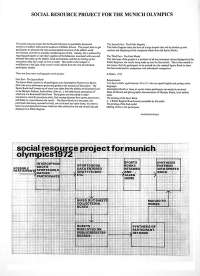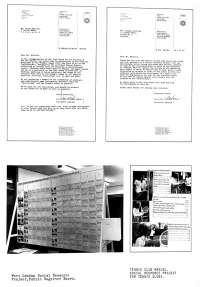The social resource project for the Munich Olympics is specifically directed at members of athletic clubs and the audience of athletic fixtures. The project aims to get participants to articulate the rules and perceptual structure of the athletic social environment, and then to mentally remodel aspects of this. Initially, this is achieved by requiring participants to vary their cognition of the behaviour associated with cues and elements that make up the athletic social environment, and then by linking up the associations they have made to form a model. This model is then subject to modification in the light of the overall model realised from the total of individual participants' models.
There are three main working parts to the project:
First Part - The Sports Book
The Sports Book is given to all participants at an Interception Point by two Sports Girls who act as information givers and guides to the structure of the project The Sports Book itself is made up of visual cues taken from the athletic environment (such as the Olympic Stadium, local athletic clubs etc. ), the behavioural associations of which are at a Restricted Coded level. Participants are then asked to make associations, identify incomplete photos, find missing elements from sports pictures etc., and finally to cross-reference the results. The Sports Book is in two parts, the participant data being recorded on both, one is retianed and taken home, the other is taken out and deposited in boxes which are then collected at the end of each day and displayed on a Public Register.
The Second Part - The Public Register
The Public Register takes the form of a large board/s that wiU be divided up into sections and displaying all the completed sheets from the Sports Books.
The Third Part - The Final Model
This third part of the project is a synthesis of all the participant returns displayed on the Public Registers, the results being made up into the final model. This is then mailed to the homes of all the participants to be entered into the retained Sports Book to show the final model and for comparison with individuals' conceptions.
S.Willats 1972
Requirements
Two Sports Girls, aged between I8 to 30, who can speak English and perhaps other languages.
Interception Booth or Area, at a point where participants can easily be involved. Maps o f Munich and photographic documentation o f Olympic Stadia, local athletic clubs.
The printing of the Sport Book
2 - 4 Public Register Boards easily accessible by the public
The printing of the final model
Mailing of this to the participants
munoly/steve/wps
The social resource project for the Munich Olympics is specifically directed at members of athletic clubs and the audience of athletic fixtures. The project aims to get participants to articulate the rules and perceptual structure of the athletic social environment, and then to mentally remodel aspects of this. Initially, this is achieved by requiring participants to vary their cognition of the behaviour associated with cues and elements that make up the athletic social environment, and then by linking up the associations they have made to form a model. This model is then subject to modification in the light of the overall model realised from the total of individual participants' models.
There are three main working parts to the project:
First Part - The Sports Book
The Sports Book is given to all participants at an Interception Point by two Sports Girls who act as information givers and guides to the structure of the project The Sports Book itself is made up of visual cues taken from the athletic environment (such as the Olympic Stadium, local athletic clubs etc. ), the behavioural associations of which are at a Restricted Coded level. Participants are then asked to make associations, identify incomplete photos, find missing elements from sports pictures etc., and finally to cross-reference the results. The Sports Book is in two parts, the participant data being recorded on both, one is retianed and taken home, the other is taken out and deposited in boxes which are then collected at the end of each day and displayed on a Public Register.
The Second Part - The Public Register
The Public Register takes the form of a large board/s that wiU be divided up into sections and displaying all the completed sheets from the Sports Books.
The Third Part - The Final Model
This third part of the project is a synthesis of all the participant returns displayed on the Public Registers, the results being made up into the final model. This is then mailed to the homes of all the participants to be entered into the retained Sports Book to show the final model and for comparison with individuals' conceptions.
S.Willats 1972
Requirements
Two Sports Girls, aged between I8 to 30, who can speak English and perhaps other languages.
Interception Booth or Area, at a point where participants can easily be involved. Maps o f Munich and photographic documentation o f Olympic Stadia, local athletic clubs.
The printing of the Sport Book
2 - 4 Public Register Boards easily accessible by the public
The printing of the final model
Mailing of this to the participants
munoly/steve/wps

